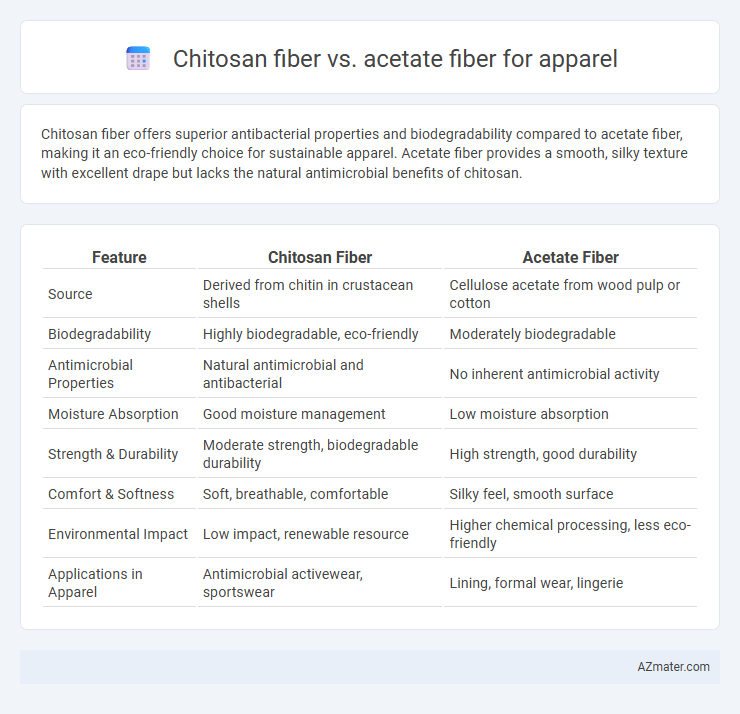Chitosan fiber offers superior antibacterial properties and biodegradability compared to acetate fiber, making it an eco-friendly choice for sustainable apparel. Acetate fiber provides a smooth, silky texture with excellent drape but lacks the natural antimicrobial benefits of chitosan.
Table of Comparison
| Feature | Chitosan Fiber | Acetate Fiber |
|---|---|---|
| Source | Derived from chitin in crustacean shells | Cellulose acetate from wood pulp or cotton |
| Biodegradability | Highly biodegradable, eco-friendly | Moderately biodegradable |
| Antimicrobial Properties | Natural antimicrobial and antibacterial | No inherent antimicrobial activity |
| Moisture Absorption | Good moisture management | Low moisture absorption |
| Strength & Durability | Moderate strength, biodegradable durability | High strength, good durability |
| Comfort & Softness | Soft, breathable, comfortable | Silky feel, smooth surface |
| Environmental Impact | Low impact, renewable resource | Higher chemical processing, less eco-friendly |
| Applications in Apparel | Antimicrobial activewear, sportswear | Lining, formal wear, lingerie |
Introduction to Chitosan and Acetate Fibers
Chitosan fiber, derived from chitin found in crustacean shells, offers natural antibacterial properties and excellent moisture management, making it ideal for functional apparel. Acetate fiber, a cellulose-based synthetic fiber, provides a smooth, silky texture with good drape and breathability, often used in luxury and formal wear. Both fibers differ significantly in origin, performance, and sustainability, influencing their specific applications in the fashion industry.
Origins and Production Processes
Chitosan fiber originates from chitin, primarily sourced from crustacean shells, and is produced through a chemical extraction process that transforms chitin into chitosan before being spun into fibers; it boasts natural biodegradability and antimicrobial properties. Acetate fiber is derived from cellulose, mainly wood pulp or cotton linters, undergoing chemical acetylation to create cellulose acetate, which is then extruded into fibers, known for its silk-like appearance and easy dyeability. Both fibers involve complex chemical treatments but differ significantly in raw material origins--marine-based for chitosan and plant-based for acetate--and in their performance attributes suitable for different apparel applications.
Fiber Structure and Chemical Composition
Chitosan fiber is composed of deacetylated chitin derived from crustacean shells, featuring a polycationic structure with abundant amino groups that provide excellent antimicrobial properties and moisture retention. Acetate fiber is synthesized from cellulose acetate, characterized by ester groups that confer smooth, lustrous texture but limited moisture absorption. The molecular structure of chitosan fibers offers superior biodegradability and enhanced functionality in apparel compared to the more synthetic and less bioactive acetate fibers.
Environmental Impact and Sustainability
Chitosan fiber, derived from natural crustacean shells, offers superior biodegradability and antimicrobial properties, significantly reducing environmental pollution compared to synthetic acetate fiber, which is produced from cellulose acetate using chemical-intensive processes. The biodegradation rate of chitosan fiber is faster, minimizing landfill accumulation and promoting sustainable waste management. Acetate fiber's reliance on petrochemical solvents and its slower decomposition contribute to higher environmental footprints, making chitosan fiber a more eco-friendly choice for sustainable apparel manufacturing.
Comfort and Wearability in Apparel
Chitosan fiber offers superior moisture absorption and antibacterial properties, enhancing comfort and reducing odor in apparel compared to acetate fiber. Acetate fiber provides a smooth, silky texture and excellent drape, but lacks the breathability and antimicrobial benefits found in chitosan fiber. The wearability of chitosan fiber makes it ideal for activewear and sensitive skin, while acetate fiber is favored for elegant, lightweight garments.
Moisture Absorption and Breathability
Chitosan fiber exhibits superior moisture absorption compared to acetate fiber due to its natural hydrophilic properties, which help to wick sweat away from the skin, enhancing comfort during wear. Its porous structure allows for better breathability, promoting air circulation that reduces heat retention in apparel. In contrast, acetate fiber tends to trap moisture and offers less ventilation, making it less effective for moisture management and overall breathability in clothing applications.
Durability and Maintenance Requirements
Chitosan fiber offers superior durability compared to acetate fiber due to its enhanced tensile strength and resistance to wear, making it ideal for long-lasting apparel. Maintenance of chitosan fiber involves less frequent washing and it resists microbial growth, reducing odor and degradation over time. Acetate fiber, while softer and cheaper, requires delicate care such as gentle washing and low heat drying, as it is prone to damage, color fading, and reduced lifespan with regular use.
Biodegradability and End-of-Life Considerations
Chitosan fiber demonstrates superior biodegradability compared to acetate fiber, breaking down naturally through microbial activity within months under composting conditions. Acetate fiber, derived from cellulose acetate, degrades more slowly due to its acetylated structure, often requiring industrial composting facilities for effective breakdown. Considering end-of-life, chitosan fibers offer an eco-friendly advantage by minimizing synthetic waste accumulation, making them favorable for sustainable apparel production.
Applications in Modern Fashion Industry
Chitosan fiber offers antibacterial properties and moisture management, making it ideal for activewear and healthcare fashion applications. Acetate fiber provides a luxurious feel and excellent drape, frequently used in evening wear and linings within the modern fashion industry. The combination of performance and aesthetics determines their specific roles in apparel design and production.
Future Prospects and Market Trends
Chitosan fiber, derived from natural chitin, shows promising growth prospects due to its biodegradability, antibacterial properties, and sustainability appeal in the eco-conscious apparel market. Acetate fiber, known for its silky texture and affordability, continues to maintain steady demand but faces challenges from increasing environmental regulations and consumer preference for green alternatives. Market trends emphasize a shift towards bio-based fibers like chitosan, driven by innovation in textile technology and rising demand for functional, eco-friendly apparel materials.

Infographic: Chitosan fiber vs Acetate fiber for Apparel
 azmater.com
azmater.com